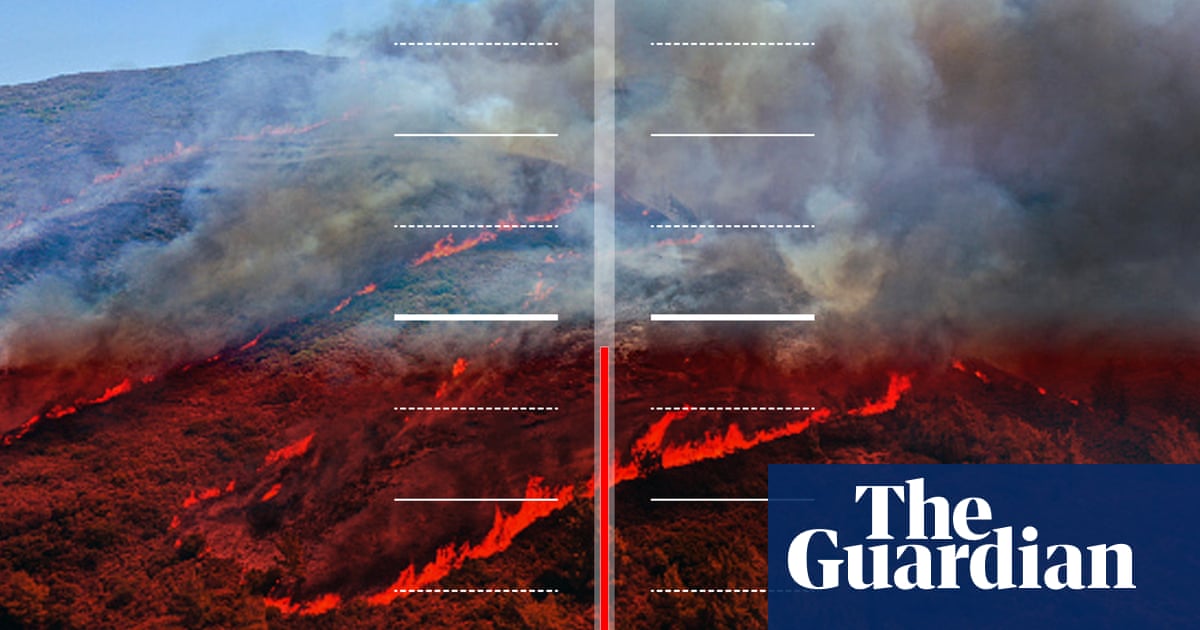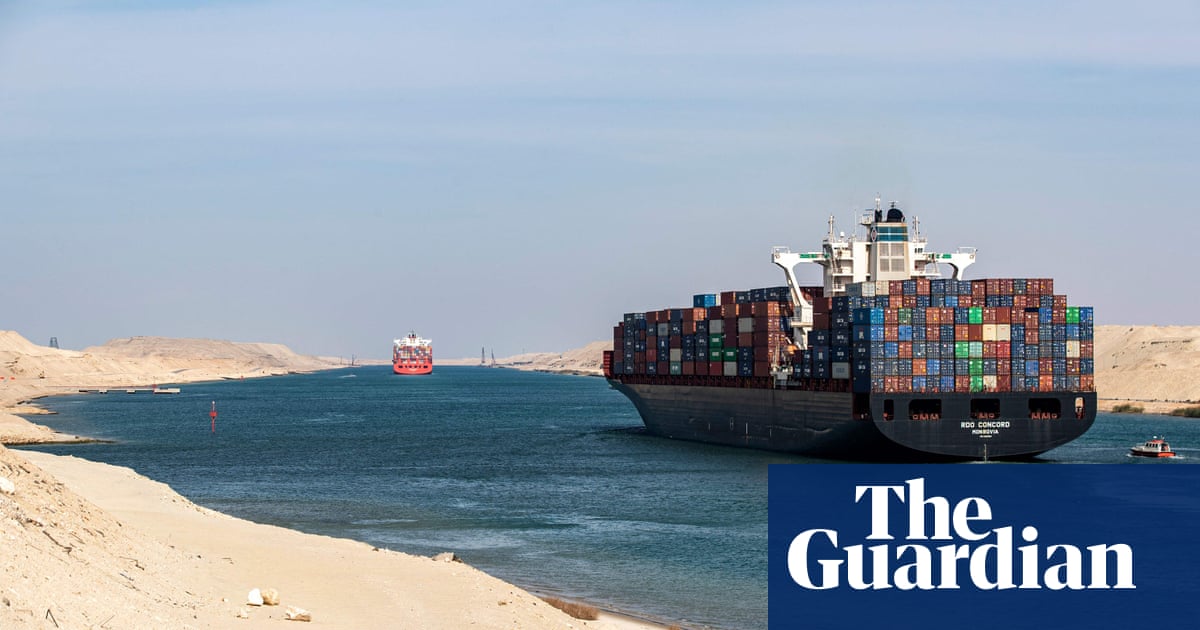
The world’s most ambitious climate target is under threat, both from physics and politics. But what would it mean for the planet and its inhabitants if humanity were to abandon the goal to limit global heating to 1.5C above preindustrial levels?
The inclusion of 1.5C (2.7F) was hailed as one of the great triumphs of the Paris climate agreement of 2015. Until then, international ambition had been limited to 2C (3.6F), much to the frustration of small island states and others on the frontline of climate disruption.
The lower target focused minds on the huge difference that half a degree makes, which was underlined by a special report three years later by the UN’s top science body, the Intergovernmental Panel on Climate Change (IPCC), which spelled out the growing risk of calamities beyond 1.5C and the urgent need to cut carbon emissions by almost half by 2030 to have any chance of preventing them.
The target was more a line in the sand than a cliff edge, but it is fast becoming a milestone on the road to climate perdition.
Eight years after Paris, the only real change has been in the severity of the climate crisis. Oil companies are racking up record profits and planning to expand production. Emissions have increased to record levels.
Boosted by an El Niño, global temperatures this year are higher than at any time in human history with devastating impacts on human mortality, ecosystem destruction and food supplies.
In the first 10 months of 2023, global heating was already running at 1.4C above preindustrial levels, and is likely to touch 1.5C in the near future.
But a single year is not enough to determine climate trends, and there is no agreed methodology for what benchmark should be used. The UK Met Office is proposing an indicator combining the last 10 years of global temperature data and projections for the next 10 years. Under this formula, the global warming level stands at 1.26C.
The speed at which 1.5C is approaching has shocked many climatologists. Several influential scientists say it will be years rather than decades before the most ambitious Paris target is breached.
“1.5C is deader than a doornail and anybody who understands the physics knows that,” James Hansen, a former Nasa climate scientist, recently told reporters.
This is a contentious statement. Other scientists disagree, including Michael Mann of the University of Pennsylvania, who said Hansen’s views were “very much out of the mainstream”.
No nation wants to go down in history for killing the world’s most ambitious climate target, but in deed, if not word, many are contributing to its demise.
“Keeping 1.5C alive is a top priority,” the Cop28 president, Sultan Al Jaber, insisted earlier this year.
But he has contributed to the wilful neglect of the target in his other role, as head of the United Arab Emirates national oil and gas company Adnoc, which is increasing production of fossil fuels at a time when the International Energy Agency says they should be phased out.
Some climate activists believe 1.5C has become a convenient fiction that satisfies a craving for hope while masking the brutal reality that the planet is on course to warm by 2.4-2.7C (4.3-4.9F) by mid-century, and well over 3C (5.4F) by 2100.
There are still many scientists and activists who want to keep fighting for 1.5C, even if there is overshoot. This is not just because it is a useful political target, but because it is a reminder that every fraction of a degree is a matter of life and death for humans and countless other species.
The Guardian asked five climate experts to explain the key differences between 1.5C and 2C.
Food, water and conflict
Drought, storms and flooding become more frequent and severe with each extra fraction of a degree of warming.
For example, the IPCC has calculated that an extreme heat event that would occur only once in a decade in a climate without human influence would happen 4.1 times a decade at 1.5C of warming, and 5.6 times at 2C.
Those worst affected are usually least to blame – the climate-vulnerable people living in countries with poor economies and weaker healthcare systems.
Seventy million more people in Africa are projected to suffer acute food security at 2C than 1.5C, according to Catherine Nakalembe, who heads the Africa programme of Nasa Harvest.
At the lower temperature, she said, computer models indicate severe drought is 30% less likely than at 2C in southern Africa, while in west Africa yields of maize and sorghum could be 40% to 50% lower at 2C than 1.5C. Water scarcity would also affect 50% fewer people at the lower target.
With greater food insecurity comes an increased risk of conflict and a greater incentive to migrate. Even at current levels, disasters are striking different parts of the continent in rapid succession, such as the dire drought that brought misery to much of east Africa in 2019, or the cyclone – named Idai – that devastated southern Africa the same year.
“I’m afraid things are only getting worse. These events wipe out entire livelihoods and happen so frequently that there’s no time to recover,” said Nakalembe. “Every fraction of a degree matters because it can make a big difference in the severity of the impacts of climate change.”
The Amazon and terrestrial biodiversity
With half a degree less breathing space, the non-human inhabitants of the planet will suffer considerable losses, which adds to stress on pollination, water quality and other biological components of the planetary life-support system.
At 2C, 18% of insect species, 16% of plants and 8% of vertebrates are projected to lose half of their habitats, at least double the proportions at 1.5C. The Amazon and other tropical rainforests would also diminish more rapidly in a dry season that is projected to be a month longer at 2C than 1.5C, with three times more likelihood of extreme heat.
This raises the prospect of the rainforest hitting a tipping point, after which it dries up and becomes a savannah with fewer global benefits of carbon sequestration, water transport and cooling.
Carlos Nobre, one of Brazil’s leading climatologists, said the current brutal Amazon drought, which has seen rivers fall to unprecedentedly low levels and mass deaths of dolphins and fish, has already brought that point closer. Further heating would make it worse.
“1.5C is not just a political target; it would cause the least impacts,” he said.
“We need to reduce the risk of accelerated warming or we will lose more emissions from the melting of the permafrost or the deforestation of the Amazon, which is close to a tipping point.
“We must achieve 1.5C. I consider this the greatest challenge humanity has ever faced.”
Coral reefs and marine ecosystems
A warming world affects the health of the world’s oceans. Acidification and oxygen depletion put pressure on fisheries on which billions of people depend.
Once vibrant coral reef systems, which are acutely sensitive to changes in temperature and the pH of the water, are already suffering bleaching events and they will increasingly “flicker out” with each a fraction of a degree rise.
At 1.5C, it may already be too late to save those in the Caribbean and parts of the western Indian Ocean. This would leave between 10% and 30% remaining in good health.
At 2C, the survival rate goes down to between 1% and 10% as the healthy patches become more isolated, vulnerable and unable to reproduce.
David Obura, the Kenyan marine biologist who heads the United Nation’s top biodiversity research group, Ipbes (the Intergovernmental Science-Policy Platform on Biodiversity and Ecosystem Services), said “there is a fighting chance for restoration” at 1.5C.
After that, each 10th of a degree makes the challenge more difficult and expensive, until 2C, after which “there is no chance that we currently know of for coral reef recovery”.
He expects Dubai to be the first Cop to discuss “minimising overshoot to keep 1.5C as a target”. This would tacitly accept that this boundary will be exceeded but to leave it as a target for the world to return to as soon as possible.
There is, however, no clear means to do this and Obura notes that every 10th of a degree of additional warming makes a return exponentially more difficult and costly. For many corals, it may be impossible, as vulnerable species and genes will have been lost.
Despite this, he acknowledges a “more realistic target of up to 2C” may be more just than “throwing resources” at efforts based on a more inspiring and ambitious target that is likely to remain out of reach.
Melting ice caps and sea level rise
Small island states see even less room for compromise. The existence of the most low-lying nations potentially depends on the half-degree between 1.5C and 2C, which will add at least 10cm to sea level rise by the end of this century, leaving an extra 10 million people at risk of flooding and storm surges.
It also raises the risk of outlier events, such as the collapse of a major Antarctic glacier.
“Our survival is at stake,” Fatumanava-o-Upolu III Dr Pa’olelei Luteru, chair of the Alliance of Small Island States, said.
“We know we must stay within the 1.5C warming limit if we are to avoid the worst impacts of climate change – impacts our islands are already suffering from, including loss of land from sea level rise, catastrophic loss of lives and homes from more frequent and severe storms, lack of drinkable water, agricultural depletion and more.”
The rapid warming of the Arctic Circle, parts of which are already 4C above preindustrial levels, have raised alarms not just of sea level rise but melting permafrost, the release of methane emissions and the disruption of the jet stream – all of which become more of a threat to human survival with each extra fraction of a degree.
“Tipping points are tipping earlier than expected,” said David King, former chief scientific adviser to the UK government. “Ice covering the north pole for hundreds of thousands of years is receding instead of reflecting sunlight back into space.”
For him, 1.5C remains the target, but he believes it will be broken very soon so sees the need for greater human intervention in the climate system.
“We must go into removal of gases and we must reflect sunlight away from the Arctic circle … there is a hell of a lot to do and very little time to do it in.”
The most important action, however, remains the eradication of fossil fuels. “We are releasing more than 30bn tonnes of greenhouse gases every year. If we continue that, we are cooked,” he said.
Adaptation and the value of compensation
Climate disruption is part of our lives. As hot as this year has been, scientists say it will seem relatively cool in the coming decades and humanity’s ability to cope becomes more difficult and expensive the more the world waits and warms.
Aïda Diongue-Niang, an IPCC lead author from the Senegal Meteorological Agency, said the UN body’s most recent synthesis report observed a growing impact on vulnerable and marginal communities, including Indigenous peoples and small-scale producers.
Although countries have agreed to create a loss and damage fund to compensate the worst-affected nations, she noted the diminishing effectiveness of economic support in a heating world. At 1.5C, money would go further in rebuilding nations than at 2C.
“The effectiveness of adaption decreases with increasing global warming,” Diongue-Niang said.
“In limiting global warming to 1.5C of global warming, warm water coral reefs, polar and mountain ecosystems, coastal wetlands and rainforests are more likely to adapt to induced changes.
“Adverse impacts, including of water availability and food production particularly in vulnerable regions and communities, and related losses and damages would be limited.”
She said the extreme weather events of 2023 should be a wake-up call for ambitious action to keep global warming level at 1.5C, or as near as possible, by the end of the century.
That is still possible, she insisted, pointing to progress made in renewable energy, but said she feared the oil industry and doubts about the possibility of change could once again curtail ambitions.
“The resistance of the fossil fuel industry and even its lobbying, as well as the selfishness of certain states and individuals, constitute a risk for 1.5C,” she said.
“I fear also that the narrative that 1.5C target is unlikely and not realistic will be put forward to delay again the actions for immediate emissions reductions.”












